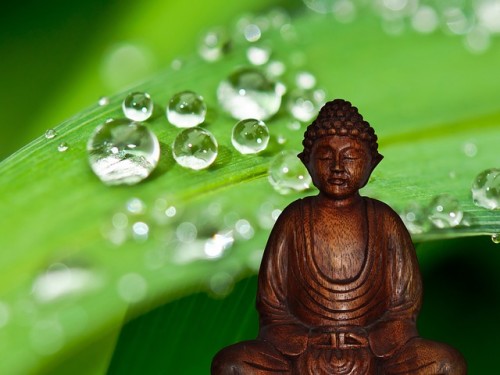No one comes to spiritual practice for “sh*ts and giggles” and this is especially true of meditation.
It is boring.
People do not learn to sit on the floor in silence for twenty or thirty minutes at a time because they want to expand their horizons. People come to spiritual practice because of suffering. Stress, emotional hang-ups and an insatiably busy mind—these are the things that bring people to meditation practice.
At an embryonic level, suffering is discontentment—it is the absence of content, meaning and vitality. In a word, discontentment is disembodiment. We live in our heads. We are disconnected from the life of the body and as a result we feel lifeless. We feel broken, like something is missing. This pervasive feeling of dissatisfaction transforms our life into a scavenger hunt.
We spend most of our time and energy looking for a fix, for that magical missing ingredient. This search is experienced as the speed and chaos between our ears.
We do not know that a felt experience of the body, an awareness of our true life is what is actually missing. So we go out of ourselves looking for something to fill the void. We turn to the job, the relationship, shopping, food, sex, alcohol or drugs in search of a fix. Eventually, we bump into someone or something that makes us feel alive. The new job arouses excitement. The new boyfriend or girlfriend makes us feel giddy. In the beginning, it seems that we have found the perfect job or our other half. We think we have found what we have been for and, in a sense, we have. The excitement resurrects the body. Once again, we begin to feel our life unfold. But we mistake the relationship or the job for the source of this wakefulness and ignore the true source—the body. In the end, we desensitize to the relationship and the job, yet again.
We drift away from the body. We move back up into our head, right back where we started. We are back at square one—disconnected, disembodied and discontented. In addition, we are frustrated with the fact that we are stuck or lost. We keep passing by the same signs, over and over again. We think that we have overcome these destructive patterns, only to wake up one day and find that we never escaped the cycle of suffering. A feeling of hopelessness arises. We get so angry that we could cry. We yearn for something different. True spiritual practice is that something different.
Meditation practice meets us on the surface. It enters into our pain and frustration, into our stress and despair. But it says, “If you want something different, you must do something different.” Rather than going out in search of a fix, meditation invites us to sit down and turn within.
Meditation begins with taking a seat. Our physical posture is like a boulder firmly planted in the middle of a moving stream. It is the stillness in the midst of our busy mind. We sit with a firm foundation, our shoulders are pulled back and our chest is open. The neck and chin form a ninety degree angle and our hands are resting palms down on our thighs. This posture is the rock to which we tether our busy minds.
Next, the practice of meditation addresses the speed and chaos between our ears. Most people think that meditation is all about controlling and silencing the mind. This is a misconception. The only response or faculty that we have at our disposal which is capable of hushing thought is thought. This does not work for obvious reasons. Thinking about not thinking only adds to the noise.
“We cannot solve our problems with the same thinking we used when we created them.” ~ Einstein
“Don’t waste time thinking about what thinking can’t change.” ~ Evagrius
Instead of trying to think ourselves out of the noise, meditation encourages us to divest in and dis-identify with thought. It invites us to open up to and reconnect with our larger life. When we notice that we are thinking about our own thoughts, we simply reconnect with the body, with the immediacy of the breath at the tip of the nose.
In meditation we tether our awareness to the body using the breath, which is rooted in the present moment. When we notice that we drifted off in thought, we simply reconnect with the coolness of the inhalation and the warmth of exhalation at the tip of the nose. No more and no less. If we do this a thousand times in twenty minutes, that is a perfect practice.
Meditation practice is not a quietistic trance; it is a practice of letting go. So the point is not to abide in a void, but to notice when your mind gets hung up and to let go.
The mind will settle according to its true nature. If clear pond water is disturbed and the mud and sediment get stirred up, the water will appear murky. When we first start sitting our minds are murky. If we try to force the mud and sediment to settle by pushing it back to the bottom, the water just gets more muddy. If we relax, sit still and just let the water settle according to its nature, it will clear up. So it is with our mind. Do not try to quiet the mind; just return to the immediacy and simplicity of the breath and the mind will settle.
Finally, meditation offers a long-term solution to the underlying problem of discontentment. It brings our awareness back into the body—back to the source of meaning, content, and vitality. This is the meaning of mindfulness.
Mindfulness is not concentration, it’s the fullness of mind. We allow the light of awareness to shine on our whole person and rather than localizing or concentrating awareness between our ears, we open the gates and allow awareness to pour out into our whole being. This reconnects us with the source of our life and destroys the pervasive feeling that we are broken or missing something. As a result, we no longer feel empty and needy. Therefore, we are no longer searching for something to fix us. The speed and stress begin to subside. Once again, our life is unfolding from within. We are not stuck.
Meditation offers a systematic and pervasive approach to the human problem of suffering that haunts us all. But it would be a mistake to think of meditation as some sort of miraculous cure.
Meditation once every now and then is hardly effective. It takes work and perseverance. We have to sit daily for at least twenty to thirty minutes. We have to practice mindfulness or embodiment, just as we practice disembodiment, if we hoped to be transformed by the practice.
~
Author: Benjamin Riggs
Editor: Katarina Tavčar
Photo: mikegi/pixabay







Read 0 comments and reply